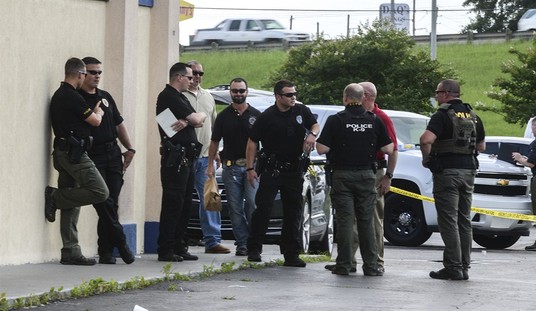The Texas General Land Office is bidding to become involved in a property dispute over a 116-mile stretch along the Red River that pits the federal Bureau of Land Management against various deed holders who have claimed ownership of the area in question for generations.
Land Office Commissioner George P. Bush, the son of former Florida governor and current Republican presidential candidate Jeb Bush, said his agency has standing to join a federal lawsuit challenging BLM claims since it manages the mineral holdings on a 113-acre tract in Wilbarger County that is part of the contested area. The office is expected to file a motion today in the U.S. District Court for the Northern District of Texas seeking permission to intervene in the challenge filed on behalf of eight individuals who fear they could be adversely affected by the agency’s actions.
“We do have an economic interest, and make no mistake – when it comes to federal takings we need to send a loud and clear message,” Bush told PJM. “It’s pretty clear, whether it’s in Texas or other states throughout the West, that this (Obama) administration is composed of unelected bureaucrats who have an inappropriate vision of land management.”
President Obama and various federal agencies under his control “think they know better than the American people,” Bush said. “Whether it’s the EPA, the BLM or the Endangered Species Act, they believe bureaucracies know better than landowners. Now they’re messing with Texas.”
The issue is a complicated one, focusing on a shifting Red River that the Bureau of Land Management maintains changes property boundaries as it changes course.
The BLM asserts that the 116-mile stretch is actually public lands as defined by a 1923 case decided by the U.S. Supreme Court in Oklahoma v. Texas. The location of the public lands moved as the river changed course, the federal agency maintains, and therefore the state of Texas shouldn’t have filed deeds from the purported property owners.
But the issue grows ever murkier. The dispute may hinge on whether the changes in the flow of the Red River came about through erosion – a gradual eating away at the banks – or avulsion — a sudden change brought about by flooding, tornado or some other natural event.
If it’s determined by the courts that the shift came as a result of erosion, under the previous court ruling the federal government might have a fairly strong case. A finding of avulsion likely would work to the landowners’ advantage.
The lawsuit claims BLM has misinterpreted high court rulings and is mistaken about the way the river has fashioned a new course. Regardless, the burden of proof will be placed on the Bureau of Land Management. Bush said the federal government’s action constitutes a simple “land grab.”
“These private landowners have been on this land for generations,” Bush said. “They have become law-abiding citizens who paid their taxes and tried to make ends meet, but they are being assaulted by another overreach of another federal bureaucracy.”
The ownership controversy comes as a result of the BLM’s effort to update its Resource Management Plan for public lands in Kansas, Oklahoma and Texas, including the now-contested area along the Red River in Wichita, Clay and Wilbarger counties. In testimony before the House Subcommittee on Public Lands & Environmental Regulation in July 2014, Steve Ellis, the BLM’s deputy director of operations, told lawmakers the process was undertaken to “establish a long-term plan articulating the BLM’s objectives and strategies for maintaining the health and productivity of public lands in the region.”
As a result, the agency conducted some limited survey work in the region in 2008 and published a new map in the Federal Register in 2014 outlining what it maintains is the new boundary for public lands, including the 116-mile stretch.
Before then, Bush said, the deed holders had no clue their property was in jeopardy. And he has no idea what the federal government plans to do with the land should it assume control.
The BLM’s action drew condemnation from, among others, then-Gov. Rick Perry and Sen. Ted Cruz (R-Texas). Rep. Mac Thornberry (R-Texas) introduced the Red River Private Property Protection Act, which, among other things, orders a survey utilizing the gradient boundary method endorsed by the Supreme Court to determine the proper boundary between private and federally owned land. The measure passed the House Natural Resources Committee on Nov. 4 and is pending on the lower chamber’s floor.
In a statement, Gov. Greg Abbott expressed support for the deed holders, whom he praised for “standing up against the federal government’s brazen attempt to take private property from Texans.”
In his subcommittee testimony, Ellis said the bureau shares the goal of providing legal certainty to property owners along the Red River “as we continue to work toward the responsible management of resources on public lands in Kansas, Oklahoma and Texas.”
Ellis said the public lands in question originally came into federal possession as part of the 1803 Louisiana Purchase. In 1867, a portion of the public domain was reserved for a Kiowa-Comanche-Apache Reservation. The “middle of the main channel” of the river — between the 98th meridian and the river’s North Fork — was established as the reservation’s southern boundary while the remaining retained its status as public land “which continues to the present.”
Ellis acknowledged that the high court adopted the gradient boundary method for determining the location of the border between Texas and Oklahoma along the river’s south bank.
“In giving certainty to the boundary’s location and the extent of tribal holdings, the court’s decisions also provided a basis for clarifying private land ownership on each side of the river,” Ellis said.
Despite the court’s determination of a defined border, certain areas along the Red River “remained in dispute,” Ellis said. In 2000, the state legislatures of Oklahoma and Texas, along with tribal leaders from the neighboring Kiowa, Comanche, and Apache Tribes and Chickasaw and Choctaw Nations, attempted to resolve these remaining issues by agreeing to the Red River Boundary Compact.
Congress consented to the compact, agreeing to set the jurisdictional boundary between the states from the south bank gradient line to the south bank vegetation line.
“Although the compact may have shifted the boundary between the states, the location and status of lands in the public domain remained unchanged,” Ellis said.
Ellis acknowledged that the “varied and, in places, uncertain ownership of lands along the Red River” has resulted in concerns from local landowners “that the BLM is seeking to expand its presence in the area or gain ownership of lands belonging to private parties.”
“Neither the department nor the BLM are expanding federal holdings along the Red River,” Ellis said. “The current work underway by the BLM through its resource management planning process is intended to identify, with certainty, and propose management alternatives for lands which fall within the public domain but have never been patented, reserved, or disposed.”









Join the conversation as a VIP Member